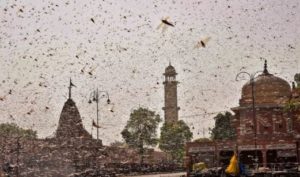
Millions Of Locusts Enter Residential Areas Of India
Thousands of locusts were caught on cam crashing the residential areas of the city on Monday, giving locals a sight that they have not seen before.
Locusts normally affect districts in western Rajasthan, but this time, swarms traveled as far as Jaipur City.
Another #LocustAttack scene from #Jaipur today. The Funny part is the guy blaming #Pakistan for this as well.After fighting #COVID__19 , India needs to Fight the #illiterates.#locusts @aajtak @anjanaomkashyap @ZeeNews @ndtvindia @ravishndtv pic.twitter.com/LwRrelx6vr
— Karan Kothari (@KaranKothari15) May 25, 2020
After Jaipur, the swarm of locusts headed towards the Dausa district.
The swarms are traveling farther and damaging trees as there are no standing crops for them to feed on.
Thousands Of Locusts Enter Residential Areas Of India
In the Murlipura and Vidhyadhar Nagar areas f Jaipur, people started to beat thalis as the locusts settled down on trees and walls.
Om Prakash, the commissioner of the state agriculture department, said:
The menace of locust has spread to 18 districts of Rajasthan and they are rapidly travelling in search of food. There is no standing crop on ground so they are staying on large trees and moving fast. Locust control teams conducted operations by sprinkling pesticide in Jaipur last night and today remaining swarms have moved towards Dausa.
The swarms are in Nagaur and reached the area of Jaipur on Sunday.
The swarms were seen in residential areas of the city on Monday and then they moved towards Dausa.
The Centre’s Locust Warning Organization in Jodhpur and the state agriculture department are currently working together so they could tackle the locust attack in Jaipur.
The latest attack happened on April 11, 2020, when the swarms entered from Pakistan and damaged the cotton crops in Ganganagar to some extent.
It is said that thousands of locusts traveled to various districts and have crossed Jaipur.
Lalchand Kataria, the Agriculture Minister of Rajasthan, conducted field visits and met the farmers.
The director of the agriculture department informed that 200 teams are working in the field to look and observe the current movements of the locusts.
Nearly 800 tractor-mounted sprayers are being used by the authorities.
He said that the fire department is also involved in the operations against the locusts.
Over 54,000 hectares of agricultural fields have been covered up by the swarms.